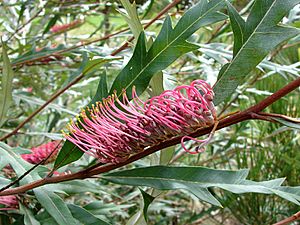Gully grevillea facts for kids
Quick facts for kids Gully grevillea |
|
|---|---|
 |
|
| A hybrid of Grevillea barklyana | |
| Scientific classification | |
| Genus: |
Grevillea
|
| Species: |
barklyana
|
Grevillea barklyana, also known as gully grevillea or large-leaf grevillea, is a special type of tree. It only grows in a certain area near Labertouche, Victoria in Australia.
Description
This tree can grow quite tall, up to 8 metres (about 26 feet). It blooms with flowers between October and December. These flowers are usually whitish-pink to fawn in color. They have pale pink to pale crimson styles, which are parts of the flower.
The leaves of the gully grevillea are long, from 5 to 27 centimetres (2 to 11 inches). They are also wide, from 2.5 to 12 centimetres (1 to 5 inches). Some leaves are smooth, while others have up to 7 or more lobes, like fingers.
Taxonomy
A botanist named Ferdinand von Mueller first officially described this plant in 1870. He published his description in a book called Flora Australiensis. The plant's scientific name, barklyana, honors Sir Henry Barkly. He was the Governor of Victoria from 1856 to 1863.
Distribution and Habitat
Grevillea barklyana grows in the upper parts of the Bunyip and Tarago Rivers. You can find it inside the Bunyip State Park and nearby State Forest areas. It likes to grow in gullies and on slopes. It prefers areas that face south. The soil it grows in is usually moist but drains water well.
Other trees that grow near it include Acacia dealbata, Eucalyptus obliqua, E. sieberi and E. regnans. These plants do not store seeds in their branches. They also cannot grow back from their roots after a bushfire. This means they need seeds in the soil to grow new plants after a fire.
Conservation
The Labertouche Wildflower Reserve was created in 1963. Its purpose was to protect many gully grevillea plants. It also protects forest boronia (Boronia muelleri) and grasstree (Xanthorrhoea australis).
This reserve became part of the Bunyip State Park in 1992. About half of all known gully grevillea plants live inside this park. The species is currently listed as "threatened" in Victoria. This listing is under the Flora and Fauna Guarantee Act 1988. It is also listed as "Vulnerable in Victoria" by the Department of Sustainability and Environment. This means it needs protection to survive.
Cultivation
Many people think Grevillea barklyana is a great plant to grow in gardens. However, it is not always easy to find in plant nurseries. People like to grow it because its pink flowers attract birds. Its leaves are also very pretty, and new growth is a reddish color.
This plant can grow well in shady spots. It can also handle some frost. It has a weak root system, so it's best to plant it where other plants can protect it from strong winds. You can grow new plants from cuttings or from seeds.
See also
 In Spanish: Grevilea de barranco para niños
In Spanish: Grevilea de barranco para niños

